Chinese Journal of Tissue Engineering Research ›› 2025, Vol. 29 ›› Issue (31): 6717-6726.doi: 10.12307/2025.615
Previous Articles Next Articles
Development of patch clamp technology in the past 10 years: visual analysis based on CiteSpace and VOSviewer
Guo Haizhen1, 2, Cong Zidong2, Zhao Yuke1, 2, Li Xiaofeng2, Yu Lu1, 2, Qian Shule1, 2, Wang Runying1, 2, Du Wuxun2
- 1Tianjin University of Traditional Chinese Medicine, Tianjin 301617, China; 2Second Affiliated Hospital of Tianjin University of Traditional Chinese Medicine, Tianjin 300150, China
-
Received:2024-06-11Accepted:2024-07-11Online:2025-11-08Published:2025-02-25 -
Contact:Du Wuxun, MD, Professor, Chief physician, Doctoral supervisor, Post-doctoral cooperative supervisor, Second Affiliated Hospital of Tianjin University of Traditional Chinese Medicine, Tianjin 300150, China -
About author:Guo Haizhen, Doctoral candidate, Tianjin University of Traditional Chinese Medicine, Tianjin 301617, China; Second Affiliated Hospital of Tianjin University of Traditional Chinese Medicine, Tianjin 300150, China -
Supported by:National Natural Science Foundation of China, No. 82004329 (to LXF); Tianjin Municipal Education Commission Scientific Research Plan Project, No. 2019SK025 (to LXF); National Famous Senior TCM Experts Inheritance Studio Construction Project “Du Wuxun National Famous Senior TCM Experts Inheritance Studio” (to DWX); Tianjin Famous TCM Inheritance Work Construction Project “Du Wuxun Tianjin Famous TCM Inheritance Studio” (to DWX)
CLC Number:
Cite this article
Guo Haizhen, Cong Zidong, Zhao Yuke, Li Xiaofeng, Yu Lu, Qian Shule, Wang Runying, Du Wuxun. Development of patch clamp technology in the past 10 years: visual analysis based on CiteSpace and VOSviewer[J]. Chinese Journal of Tissue Engineering Research, 2025, 29(31): 6717-6726.
share this article
Add to citation manager EndNote|Reference Manager|ProCite|BibTeX|RefWorks
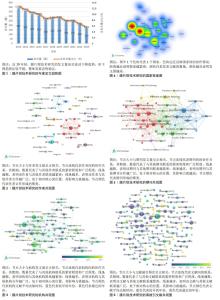
2.1 年度发文趋势结果 通过对膜片钳技术的相关文献进行年度发表文献趋势可视化分析,见图1。可以发现,近10年膜片钳技术的相关研究发文量虽呈波动下降趋势,但较前并未出现骤减情况,表明该领域研究热度虽然有所下降,但整体发展态势稳定。 2.2 作者可视化结果 膜片钳技术研究领域文献共有14 120个作者。根据普赖斯定律的核心作者的计算公式[17],计算出核心作者中的最低发文量M≈3.745,约为4篇。因此,统计出发文量≥4篇核心作者共587位。其中,发文量≥10篇的核心作者有52位,见图2。统计结果显示:在膜片钳技术研究领域并未形成显著的核心作者群,但核心作者之间形成了稳定的合作团队。Park,Won Sun团队(韩国全北国立大学)、Chu,Li团队(中国河北省心脑血管病中医药防治研究重点实验室)、Ackerman,Michael J.团队(美国明尼苏达州罗切斯特市梅奥诊所)和Hahn,Sang June团队(韩国加图立大学)是4个较大且相对稳定的学术团队。作者发文量排名前5名的分别为Jang,Il-Sung(25篇,韩国庆北大学)、Park,Won Sun(23篇,韩国江原国立大学)、Hahn,Sang June(21篇,韩国加图立大学)、Han,Seong Kyu(21篇,韩国全北国立大学)和Bae,Young Min(17篇,韩国江原国立大学)。 2.3 机构可视化结果 对膜片钳技术研究领域文献中所涉及的机构进行统计,共涉及2 465个机构。其中,发文量≥15篇共76个机构,见图3。结果显示:在膜片钳技术研究领域涉及的机构较多,机构之间具有密切的联系。其中,Chinese Acad Sci(中国科学院,中国,连接数16)是与其他机构联系最广泛的机构,具有较大的影响力,其次是Chinese Acad Med Sci(中国医学科学院,连接数13)、Wuhan Univ(武汉大学,连接数12)、Fudan Univ(复旦大学,连接数11)和Nanjing Med Univ(南京医科大学,连接数11)。发文量频次排名前5位的机构是Fudan Univ(61篇)、Harbin Med Univ (哈尔滨医科大学,57篇)、Chinese Acad Sci(46篇)、Huazhong Univ Sci & Technol(华中科技大学, 40篇)、Russian Acad Sci(俄罗斯科学院,37篇)。 2.4 国家可视化结果 2013-2023年全球共涉及77个国家发表了膜片钳技术相关文献。其中,发文量≥7篇有42个国家。如图4所示。统计结果显示:在膜片钳技术的研究,各国之间均有不同程度的联系。其中美国(连接数39)是与其他国家联系最广泛的国家,其次是德国(连接数35)、英格兰(连接数31)、法国(连接数27)和中国(连接数23)。发文量中国(911篇)排名第一,拥有超过900份出版物(占总数的29.87%),紧随之后的是美国(882篇)、日本(305篇)、德国(298篇)和韩国(191篇)。 2.5 期刊可视化结果 对膜片钳技术研究领域文献的出版期刊进行统计,共涉及638家期刊。其中,发文量≥12篇有55家期刊,见图5。统计结果显示:对于膜片钳技术的研究,期刊之间联系密切,研究内容涉及神经科学、药理学、生理学、分子生物学、细胞生物学等多个学科。《Journal of Neuroscience》(连接数25)是与其他期刊合作最广泛的期刊,具有较大的影响力,其次是《European Journal of Pharmacology 》(连接数24)、《Journal of Neurophysiology(神经生理学杂志)》(连接数23)、《International Journal of Molecular Sciences》(连接数21)和《Plos One(公共科学图书馆?综合)》(连接数21)。从发文量来看,《Journal of Neuroscience》(130篇)遥遥领先;其次是《Plos One》(86篇)、《European Journal of Pharmacology》(75篇)、《Journal of Neurophysiology》(75篇)和《International Journal of Molecular Sciences》(58篇)。 2.6 高被引文献结果 对膜片钳技术研究领域文献进行统计,共有3 050篇文章。其中,被引频次≥50次有171篇,如图6所示。统计结果显示:被引频次排名第一的Jiang (2015)高达503次,其次为Talantova (2013)、Polack (2013)、Cork (2015)和Ko(2013)[18-22],详见表1。 "

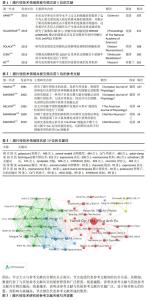
2.7 参考文献共被引结果 膜片钳技术研究领域中共有101 498条共被引的参考文献。其中,共被引频次≥20次有57条参考文献,如图7所示。统计结果显示:在膜片钳技术研究领域共被引参考文献数量众多,参考文献之间存在活跃的共被引[23-27]。Hamill OP在1982年发表于《European Journal of Physiology》上的文献共被引频次最高,详见表2。 2.8 关键词可视化结果 2.8.1 关键词共现结果 对某一研究领域所刊文献的主要关键词进行共现网络分析,有助于直观且全面地了解该领域近年来的主要研究热点。膜片钳技术领域共涉及13 400个关键词。其中,出现频次≥50次有71个关键词,见图8。统计结果显示:从关键词出现的频次来看,potassium(钾离子)出现的频次最多;其次是animal-model(动物模型)、Ca2+(钙离子)、patch-clamp techniques(膜片钳技术)等。从关键词连线数量来看,activation(激活)、animal-model(动物模型)及channels(通道)等与其他关键词紧密程度较高,具有较强的影响力,详见表3。"
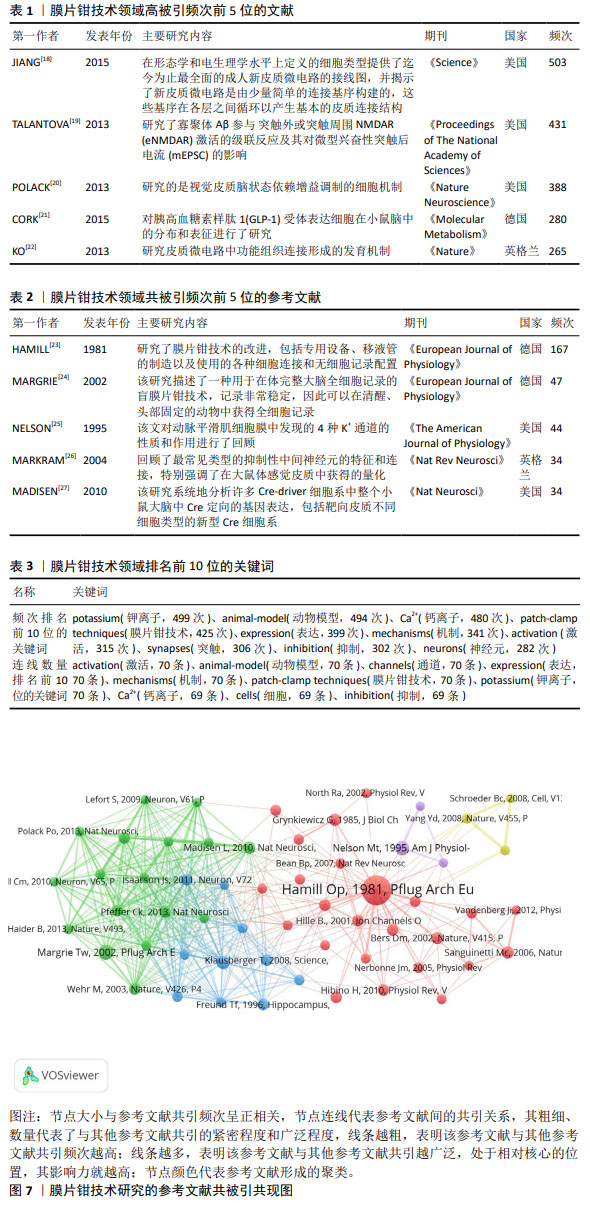
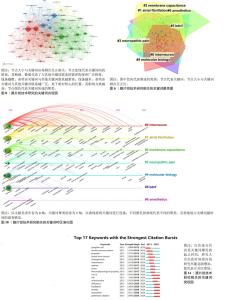
2.8.2 关键词聚类和时区演化结果 关键词聚类分析是将文献中具有相似内涵的关键词词群进行归类总结分析,以协助研究者快速掌握该领域研究的方向[28]。在Citespace软件中,选用对数似然算法对关键词进行聚类分析,见图9。统计结果显示:在膜片钳技术的研究领域,共形成了7个关键词聚类标签,图谱中Modularity值为0.359 2 > 0.3,Mean Silhouette值为0.666 8 > 0.5,表明此次聚类为高效的[29]。聚类#0(interneuron,中间神经元)的内容多集中采用膜片钳技术观察各大脑区域(丘脑、前额叶皮质、杏仁核等)自发或刺激后诱发的阈下动力学变化、神经系统疾病病理机制和神经行为学调节机制;聚类#1(atrial fibrillation,心房颤动)研究的主要是心血管系统疾病的病理机制及其药物治疗的电生理特征;聚类#2 (membrane capacitance,膜电容)和#4(molecular biology,分子生物学)主要是研究各种疾病状态下细胞膜电容特性及其分子生物学机制;聚类#3 (neuropathic pain神经病理性疼痛)关注神经的抑制性调节机制,如镇痛药物对神经病理性疼痛的镇痛机制;聚类#5(bdnf,脑源性神经营养因子)主要研究中枢神经系统氨基酸、肽和蛋白质等受体的表达与释放,尤其是脑源性神经营养因子表达及其相关信号通路研究;聚类#6(anesthetics,麻醉剂)研究重点为麻醉剂作用的电生理机制。 关键词时区演化是在关键词聚类的基础上进行分析,侧重于勾画聚类关键词的历史跨度,根据时间跨度说明该聚类下研究内容的发展时间以及连贯性,从而明晰发展趋势。在CiteSpace软件进行分析,选择“timeline”模块进行分析,见图10。统计结果显示:在近10年膜片钳技术领域中,聚类#0,#1,#2,#3,#4一直受到学者关注,是该领域的研究热点;而聚类#5和聚类#6的研究近年趋冷。 2.8.3 关键词突现结果 突现分析是指关键词在某个时期内有较高的引用率,这可以测试一个研究领域在一定时期内是否热门以及突出新出现的热点[30-31]。如果这些出现的概率高于数据的全局阈值,则认为这些关键词为突现词,主要体现研究前沿并预测研究发展方向[32]。在CiteSpace软件中,选择“Burstness”模块进行图谱绘制,见图11。统计分析得到17个突现词,分别为:ganglion cell(神经节细胞)、central nervous system(中枢神经系统)、propofol(异丙酚)、dorsal horn neuron(背角神经元)、schizophrenia (精神分裂症)、motoneuron(运动神经元)、asthma(哮喘)、stress(应激)、electrophysiological property(电生理特性)、circuit(回路)、risk(风险)、mitochondria(线粒体)、deficiency(缺陷)、oscillation(振荡)、anxiety(焦虑)、association(联想)和parkinsons disease(帕金森病)。 "
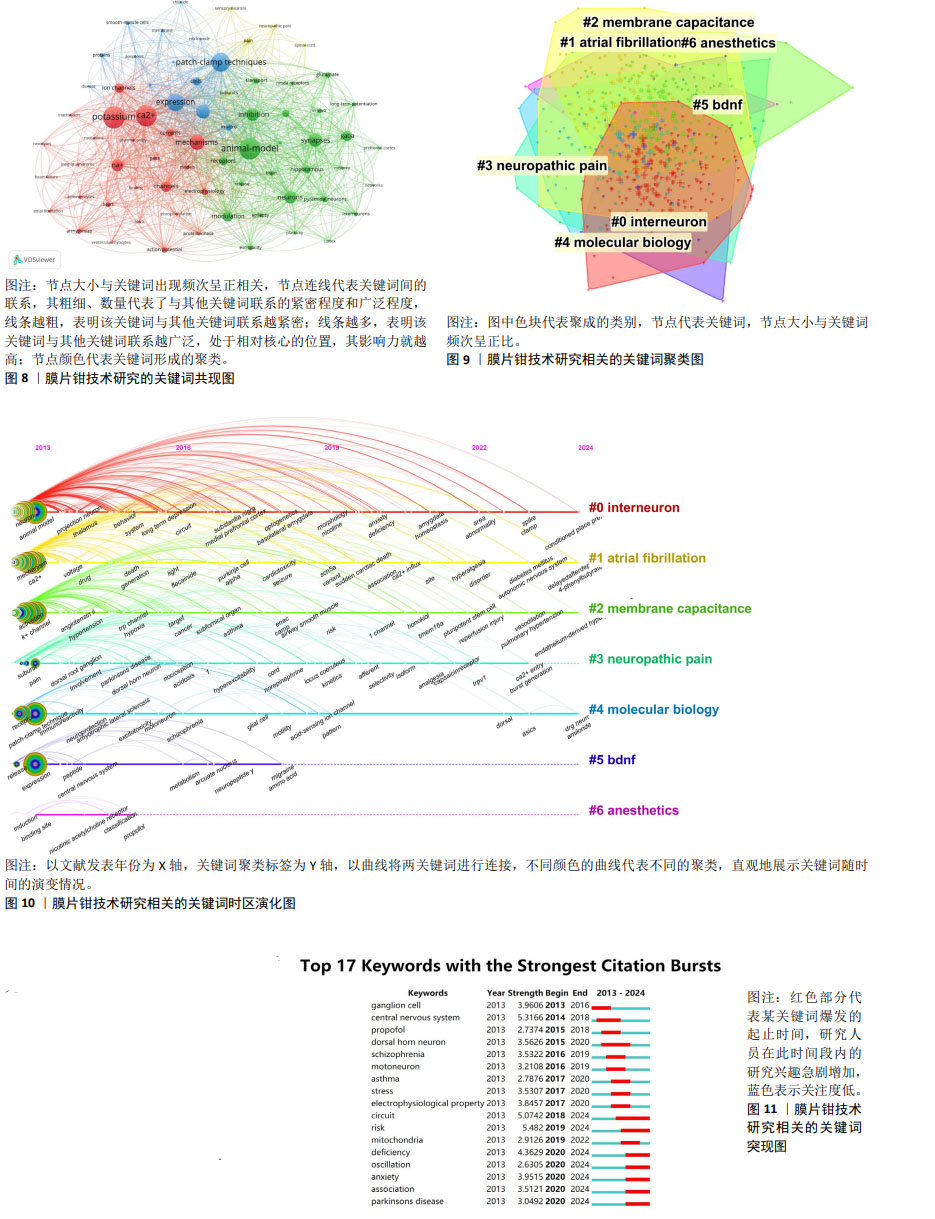
| [1] 黄燕云,高洁,张利娜,等.利用全细胞膜片钳技术记录大鼠脑片NMDA电流的研究[J].中国应用生理学杂志,2021, 37(5):459-462. [2] 于婷婷,丁懿宁,阎美卉,等.基于膜片钳技术的丹红注射液对人诱导多能干细胞衍生心肌细胞电生理的影响研究[J]. 药物评价研究,2024,47(5):1010-1016. [3] BELL D C, FERMINI B. Use of automated patch clamp in cardiac safety assessment: past, present future perspectives. J Pharmacol Toxicol Methods. 2021;111: 107114. [4] LOVISOLO D. Patch clamp: the first four decades of a technique that revolutionized electrophysiology and beyond. Rev Physiol Biochem Pharmacol. 2023;186:1-28. [5] ROGERS M, OBERGRUSSBERGER A, KONDRATSKYI A, et al. Using automated patch clamp electrophysiology platforms in ion channel drug discovery: an industry perspective. Expert Opin Drug Discov. 2024; 19(5):523-535. [6] MELGARI D, CALAMAIO S, FROSIO A, et al. Automated patch-clamp and induced pluripotent stem cell-derived cardiomyocytes: a synergistic approach in the study of brugada syndrome. Int J Mol Sci. 2023;24(7):6687. [7] NOGUCHI A, IKEGAYA Y, MATSUMOTO N. In vivo whole-cell patch-clamp methods: recent technical progress and future perspectives. Sensors (Basel). 2021;21(4): 1448. [8] HORVATH B, SZENTANDRASSY N, DIENES C, et al. Exploring the coordination of cardiac ion channels with action potential clamp technique. Front Physiol. 2022;13:864002. [9] GAO J, LIAO C, LIU S, et al. Nanotechnology: new opportunities for the development of patch-clamps. J Nanobiotechnology. 2021;19(1):97. [10] LINDERS LE, SUPIOT LF, DU W, et al. Studying synaptic connectivity and strength with optogenetics and patch-clamp electrophysiology. Int J Mol Sci. 2022; 23(19):11612. [11] JIANG F, ZHANG F, SU Y, et al. Knowledge mapping of disease-modifying therapy (DMT) in multiple sclerosis (MS): a bibliometrics analysis. Heliyon. 2024;10(11): e31744. [12] QU F, WANG G, WEN P, et al. Knowledge mapping of immunotherapy for breast cancer: a bibliometric analysis from 2013 to 2022. Hum Vaccin Immunother. 2024;20(1):2335728. [13] ZHANG L, LI Y, ZHANG Y, et al. Development and trends in metabolomics studies in psoriasis: a bibliometric analysis of related research from 2011 to 2024. Heliyon. 2024; 10(8):e29794. [14] ALMUHAIDIB S, ALQAHTANI R, ALOTAIBI HF, et al. Mapping the landscape of medical research in the Arab world countries: a comprehensive bibliometric analysis. Saudi Med J. 2024;45(4):387-396. [15] CHEN L, CHEN J, WU M, et al. Analyzing the bibliometrics of brain-gut axis and Parkinson’s disease. Front Neurol. 2024; 15:1343303. [16] LANG X, LI L, LI Y, et al. Effect of diabetes on wound healing: a bibliometrics and visual analysis. J Multidiscip Healthc. 2024; 17:1275-1289. [17] 张子婷,郑彦宁,袁芳.多指标核心作者识别方法研究[J].现代情报,2020,40(7): 144-151. [18] JIANG X, SHEN S, CADWELL CR, et al. Principles of connectivity among morphologically defined cell types in adult neocortex. Science. 2015;350(6264):aac9462. [19] TALANTOVA M, SANZ-BLASCO S, ZHANG X, et al. Aβ induces astrocytic glutamate release, extrasynaptic NMDA receptor activation, and synaptic loss. Proc Natl Acad Sci India Sect B Biol Sci. 2013;110(27): E2518-E2527. [20] POLACK P, FRIEDMAN J, GOLSHANI P. Cellular mechanisms of brain state-dependent gain modulation in visual cortex. Nat Neurosci. 2013;16(9):1331-1339. [21] CORK SC, RICHARDS JE, HOLT MK, et al. Distribution and characterisation of glucagon-like peptide-1 receptor expressing cells in the mouse brain. Mol Metab. 2015; 4(10):718-731. [22] KO H, COSSELL L, BARAGLI C, et al. The emergence of functional microcircuits in visual cortex. Nature. 2013;496(7443):96-100. [23] HAMILL OP, MARTY A, NEHER E, et al. Improved patch-clamp techniques for high-resolution current recording from cells and cell-free membrane patches. Pflugers Arch. 1981;391(2):85-100. [24] MARGRIE TW, BRECHT M, SAKMANN B. In vivo, low-resistance, whole-cell recordings from neurons in the anaesthetized and awake mammalian brain. Pflugers Arch. 2002;444(4):491-498. [25] NELSON MT, QUAYLE JM. Physiological roles and properties of potassium channels in arterial smooth muscle. Am J Physiol. 1995;268(4 Pt 1):C799-C822. [26] MARKRAM H, TOLEDO-RODRIGUEZ M, WANG Y, et al. Interneurons of the neocortical inhibitory system. Nat Rev Neurosci. 2004;5(10):793-807. [27] MADISEN L, ZWINGMAN T A, SUNKIN S M, et al. A robust and high-throughput Cre reporting and characterization system for the whole mouse brain. Nat Neurosci. 2010;13(1):133-140. [28] ZHAO ML, LU ZJ, YANG L, et al. The cardiovascular system at high altitude: a bibliometric and visualization analysis. World J Cardiol. 2024;16(4):199-214. [29] HUO Q, LUO X, XU Z, et al. Machine learning applied to epilepsy: bibliometric and visual analysis from 2004 to 2023. Front Neurol. 2024;15:1374443. [30] XU D, WANG Y, WANG K, et al. A scientometrics analysis and visualization of depressive disorder. Curr Neuropharmacol. 2021;19(6):766-786. [31] YAN W, ZHENG K, WENG L, et al. Bibliometric evaluation of 2000-2019 publications on functional near-infrared spectroscopy. Neuroimage. 2020;220:117121. [32] KIM MC, NAM S, WANG F, et al. Mapping scientific landscapes in UMLS research: a scientometric review. J Am Med Inform Assoc. 2020;27(10):1612-1624. [33] TAO C, ZHANG G, XIONG Y, et al. Functional dissection of synaptic circuits: in vivo patch-clamp recording in neuroscience. Front Neural Circuits. 2015;9:23. [34] SUK HJ, BOYDEN ES, van WELIE I. Advances in the automation of whole-cell patch clamp technology. J Neurosci Methods. 2019;326: 108357. [35] PARK S, KANG M, HEO R, et al. Inhibition of voltage-dependent K+ channels by antimuscarinic drug fesoterodine in coronary arterial smooth muscle cells. Korean J Physiol Pharmacol. 2022;26(5):397-404. [36] SEO MS, AN JR, JUNG HS, et al. Suppression of voltage-gated K+ channels by darifenacin in coronary arterial smooth muscle cells. Eur J Pharmacol. 2021;891:173707. [37] AN JR, JUNG HS, SEO MS, et al. The effects of tegaserod, a gastrokinetic agent, on voltage-gated K+ channels in rabbit coronary arterial smooth muscle cells. Clin Exp Pharmacol Physiol. 2021;48(5):748-756. [38] AN JR, SEO MS, JUNG HS, et al. The inhibitory effect of ziprasidone on voltage-dependent K+ channels in coronary arterial smooth muscle cells. Biochem Biophys Res Commun. 2020;529(2):191-197. [39] ZHANG M, QI J, HE Q, et al. Liquiritigenin protects against myocardial ischemic by inhibiting oxidative stress, apoptosis, and L-type Ca2+ channels. Phytother Res. 2022;36(9):3619-3631. [40] LI J, YANG Y, WANG H, et al. Baicalein ameliorates myocardial ischemia through reduction of oxidative stress, inflammation and apoptosis via tlr4/myd88/mapks/NF-κB pathway and regulation of Ca2+ homeostasis by l-type Ca2+ channels. Front Pharmacol. 2022;13:842723. [41] ZHAO Z, LIU M, ZHANG Y, et al. Cardioprotective effect of monoammonium glycyrrhizinate injection against myocardial ischemic injury in vivo and in vitro: involvement of inhibiting oxidative stress and regulating Ca2+ homeostasis by L-type calcium channels. Drug Des Devel Ther. 2020;14:331-346. [42] WU D, YU N, GAO Y, et al. Targeting a vulnerable septum-hippocampus cholinergic circuit in a critical time window ameliorates tau-impaired memory consolidation. Mol Neurodegener. 2023;18(1):23. [43] TIAN T, CAI Y, QIN X, et al. Forebrain E-I balance controlled in cognition through coordinated inhibition and inhibitory transcriptome mechanism. Front Cell Neurosci. 2023;17:1114037. [44] ZHU J, CHEN C, LI Z, et al. Overexpression of Sirt6 ameliorates sleep deprivation induced-cognitive impairment by modulating glutamatergic neuron function. Neural Regen Res. 2023;18(11):2449-2458. [45] PENG X, MAO Y, TAI Y, et al. Characterization of anxiety-like behaviors and neural circuitry following chronic moderate noise exposure in mice. Environ Health Perspect. 2023;131(10):107004. [46] HUANG M, YANG Z, LI Y, et al. Dopamine D1/D5 receptor signaling is involved in arrhythmogenesis in the setting of takotsubo cardiomyopathy. Front Cardiovasc Med. 2021;8:777463. [47] XU Q, HUANG X, MENG Z, et al. Antiarrhythmic effects of vernakalant in human-induced pluripotent stem cell-derived cardiomyocytes from a patient with short QT syndrome Type 1. J Cardiovasc Dev Dis. 2022;9(4):112. [48] ZHONG R, ZHANG F, YANG Z, et al. Epigenetic mechanism of L-type calcium channel beta-subunit downregulation in short QT human induced pluripotent stem cell-derived cardiomyocytes with CACNB2 mutation. Europace. 2022;24(12):2028-2036. [49] LIU P, YANG Y, ZHANG H, et al. The effect of TWIK-1 two pore potassium channels on cardiomyocytes in low extracellular potassium conditions. Front Biosci (Landmark Ed). 2023;28(3):51. [50] NAGARAJA RY, STILES MA, SHERRY DM, et al. Synapse-specific defects in synaptic transmission in the cerebellum of W246G mutant ELOVL4 rats-a model of human SCA34. J Neurosci. 2023;43(33):5963-5974. [51] CHEN YC, RINDNER DJ, FOWLER JP, et al. Extracellular ATP neurotransmission and nicotine sex-specifically modulate habenular neuronal activity in adolescence. J Neurosci. 2023;43(48):8259-8270. [52] 韩昕,李莎莎,陈曦,等.基于CiteSpace和VOSviewer对女贞子的研究现状与热点分析[J].特产研究,2024,46(3):47-55. [53] LIU H, FANG X, MA Q, et al. Research hotspots of polycystic ovary syndrome and hyperandrogenism from 2008 to 2022: bibliometric analysis. Gynecol Endocrinol. 2024;40(1):2326102. [54] 贾炜姣,代广斌,耿国帅,等.膜片钳技术在细胞电生理研究方面的最新应用[J].高校化学工程学报,2018,32(4):767-778. [55] LLANOS MA, ENRIQUE N, ESTEBAN-LOPEZ V, et al. A combined ligand- and structure-based virtual screening to identify novel NaV1.2 blockers: in vitro patch clamp validation and in vivo anticonvulsant activity. J Chem Inf Model. 2023;63(22):7083-7096. [56] DALLAS ML, BELL D. Advances in ion channel high throughput screening: where are we in 2023? Expert Opin Drug Discov. 2024;19(3):331-337. [57] YANG Y, LIU A, TSAI CT, et al. Cardiotoxicity drug screening based on whole-panel intracellular recording. Biosens Bioelectron. 2022;216:114617. [58] ZHAO Q, ZHANG X, LONG S, et al. Licochalcone mediates the pain relief by targeting the voltage-gated sodium channel. Mol Pharmacol. 2023;104(4):133-143. [59] GONG JH, ZHANG CM, WU B, et al. Central and peripheral analgesic active components of triterpenoid saponins from Stauntonia chinensis and their action mechanism. Front Pharmacol. 2023;14:1275041. [60] ANNECCHINO LA, SCHULTZ SR. Progress in automating patch clamp cellular physiology. Brain Neurosci Adv. 2018;2: 2398212818776561. |
| [1] | Lai Pengyu, Liang Ran, Shen Shan. Tissue engineering technology for repairing temporomandibular joint: problems and challenges [J]. Chinese Journal of Tissue Engineering Research, 2025, 29(在线): 1-9. |
| [2] | Liang Haobo, Wang Zeyu, Ma Wenlong, Liu Hao, Liu Youwen. Hot issues in the field of joint revision: infection, rehabilitation nursing, bone defect, and prosthesis loosening [J]. Chinese Journal of Tissue Engineering Research, 2025, 29(9): 1963-1971. |
| [3] | Liu Lin, Liu Shixuan, Lu Xinyue, Wang Kan. Metabolomic analysis of urine in a rat model of chronic myofascial trigger points [J]. Chinese Journal of Tissue Engineering Research, 2025, 29(8): 1585-1592. |
| [4] | Su Xiaoyang, Chen Wenting, Fu Yidan, Zhao Yan, Lan Danfeng, Yang Qiuping. Correlation between Mer receptor tyrosine kinase and diabetic peripheral neuropathy in Sprague-Dawley rats [J]. Chinese Journal of Tissue Engineering Research, 2025, 29(8): 1593-1599. |
| [5] | Li Kaiying, Wei Xiaoge, Song Fei, Yang Nan, Zhao Zhenning, Wang Yan, Mu Jing, Ma Huisheng. Mechanism of Lijin manipulation regulating scar formation in skeletal muscle injury repair in rabbits [J]. Chinese Journal of Tissue Engineering Research, 2025, 29(8): 1600-1608. |
| [6] | Li Jun, Gong Jingjing, Sun Guobin, Guo Rui, Ding Yang, Qiang Lijuan, Zhang Xiaoli, Fang Zhanhai . miR-27a-3p promotes the proliferation of human hypertrophic scar fibroblasts by regulating mitogen-activated protein kinase signaling pathway [J]. Chinese Journal of Tissue Engineering Research, 2025, 29(8): 1609-1617. |
| [7] | Li Huayuan, Li Chun, Liu Junwei, Wang Ting, Li Long, Wu Yongli. Effect of warm acupuncture on PINK1/Parkin pathway in the skeletal muscle of rats with chronic fatigue syndrome [J]. Chinese Journal of Tissue Engineering Research, 2025, 29(8): 1618-1625. |
| [8] | Jing Ruyi, Chen Yingxin, Cao Lei . Prognosis of deep lamellar keratoplasty versus penetrating keratoplasty in the treatment of stromal corneal dystrophy [J]. Chinese Journal of Tissue Engineering Research, 2025, 29(8): 1626-1633. |
| [9] | Wang Xuanqiang, Zhang Wenyang, Li Yang, Kong Weiqian, Li Wei, Wang Le, Li Zhongshan, Bai Shi. Effects of chronic exposure to low-frequency pulsed magnetic fields on contractility and morphology of the quadriceps muscle in healthy adults [J]. Chinese Journal of Tissue Engineering Research, 2025, 29(8): 1634-1642. |
| [10] | Zhang Yuxin, Yu Cong, Zhang Cui, Ding Jianjun, Chen Yan. Differences in postural control ability between older adults with mild cognitive impairment and those with normal cognition under different single-task and dual-task conditions [J]. Chinese Journal of Tissue Engineering Research, 2025, 29(8): 1643-1649. |
| [11] | Zhou Panpan, Cui Yinglin, Zhang Wentao, Wang Shurui, Chen Jiahui, Yang Tong . Role of cellular autophagy in cerebral ischemic injury and the regulatory mechanism of traditional Chinese medicine [J]. Chinese Journal of Tissue Engineering Research, 2025, 29(8): 1650-1658. |
| [12] | Yu Jingbang, Wu Yayun. Regulatory effect of non-coding RNA in pulmonary fibrosis [J]. Chinese Journal of Tissue Engineering Research, 2025, 29(8): 1659-1666. |
| [13] | Wang Qiuyue, Jin Pan, Pu Rui . Exercise intervention and the role of pyroptosis in osteoarthritis [J]. Chinese Journal of Tissue Engineering Research, 2025, 29(8): 1667-1675. |
| [14] | Zhu Hanmin, Wang Song, Xiao Wenlin, Zhang Wenjing, Zhou Xi, He Ye, Li Wei, . Mitophagy regulates bone metabolism [J]. Chinese Journal of Tissue Engineering Research, 2025, 29(8): 1676-1683. |
| [15] | Yuan Weibo, Liu Chan, Yu Limei. Potential application of liver organoids in liver disease models and transplantation therapy [J]. Chinese Journal of Tissue Engineering Research, 2025, 29(8): 1684-1692. |
| Viewed | ||||||
|
Full text |
|
|||||
|
Abstract |
|
|||||